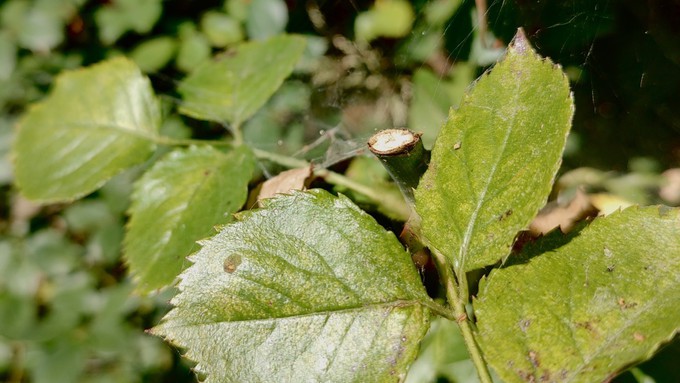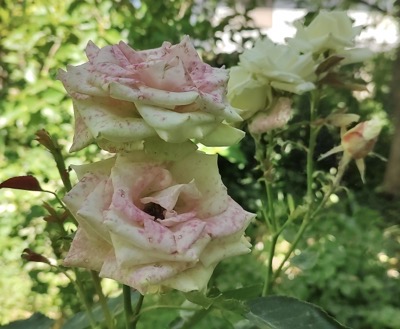
Cold spring weather created challenges; how to get your roses looking their best

Spider mite damage is evident in these rose leaves, which show stippling and light webbing from the pests. Debbie Arrington
All that winter rain refreshed bushes and renewed their vigor; from frontyards to public gardens, we saw tons of roses. But we also saw massive outbreaks of fungal disease and spider mites.
That first flush of flowers came later than usual – more May roses when typically mid April sees the most blooms. That was due to cooler than normal spring temperatures. The first flush extended into early June, especially for foothill gardeners.
Coupled with lots of moisture, those coolish temperatures made for ideal conditions for fungal diseases such as powdery mildew, rust, blackspot and botrytis (or gray mold). Usually in Sacramento, these fungal outbreaks don’t crop up until fall or are short-lived. But they’ve been enjoying afternoons in the 70s or 80s and warm nights.
Powdery mildew, rust and blackspot can defoliate a bush; the fungal disease attacks the foliage and slowly kills it. Powdery mildew – which looks like plants were lightly dusted with flour – also goes after buds and tender shoots.

Botrytis destroys blooms. On white or light-colored roses, infected petals look like they have measles. (For example, my white Whirlaway is covered with pink polka dots.) Infected flowers often refuse to open and instead turn to mush on the stem.
The good news: Temperatures in the high 90s (or hotter) coupled with dry conditions will make these diseases disappear. Hot, dry days are coming soon – it’s summer in Sacramento!
To help protect the bush from further outbreaks, gather up the fallen leaves and petals and dispose of them. Snip off infected foliage and buds still on the bush. Deep water and feed the plant with balanced rose fertilizer; it needs food to replace those lost leaves midseason while still producing more flowers. Apply about 2 inches of mulch (preferably wood chips or bark) around the bush; that retains moisture as well as cuts down on weeds – and more disease.
More growth on plants offers more for pests to eat. So this has been a boom year for bugs, too.
Aphids are always a spring and summer issue with roses. They attack the new growth. The faster that roses grow, the more vulnerable they are to aphid attacks. Ants often introduce aphids onto plants, then harvest their honeydew, aphids’ sweet secretion.
If you see ants crawling up rose canes, knock them off with a blast from the hose. Water works wonders on aphids, too; they can’t swim. Use the hose to rinse them off tender new growth; the aphids won’t survive the shower. At the same time, you’re giving your rose a little extra water and warding off spider mites.
Water is the best cure for spider mites, which can quickly overwhelm a plant. Watch out for their telltale webs and stippling on leaves.
Here’s advice from master rosarian and retired state entomologist Baldo Villegas, Sacramento’s Bug Man:
“Spider mites are usually present in one’s garden all the time,” says Villegas, who grows more than 3,000 bushes at his Orangevale home. “If we overuse broad spectrum insecticides such as Orthene, the natural enemies are killed off and the spider mites are not kept at low levels.
“As the temperature starts to climb up into the 90s, check the roses in the areas of the yard that are the hottest!” he adds. “Look for the diagnostic leaf stippling which they produce by their sucking mouthparts then turn the leaves over so that you can see the undersides and look for the presence of silken webbing which they produce as nesting material. If you spot this type of damage take immediate action otherwise the roses will loose their foliage if the infestation is severe.”
Baldo prefers using water to fight mites. “Miticides or pesticides that kill spider mites are very expensive and hard to get. … Insecticidal soaps and horticultural oils can also be used but these are contact action pesticides and you need to get under the foliage and to get a thorough spray where the spider mites are located. Because of this, I normally leave chemical control of spider mites as a last resort and let my irrigation system control them. If I see a new infestation starting, I place extra misting emitters from my drip line under infected plants and let the emitters wash the foliage from underneath the plants.”
You also can do this with a hose, washing off dust, webs and mites as you give your plants a bath. Spider mites thrive in dry, dusty places. Their natural enemies usually catch up with their populations by mid-summer and keep mite infestations under control.
To keep roses blooming this summer, remember to “deadhead” – removing spent flowers. Trim the stem back to at least the first five-leaflet leaf. Expect new flowers in six to eight weeks.
For more information on rose diseases: https://ipm.ucanr.edu/PMG/PESTNOTES/pn7463.html.
For spider mites: https://ipm.ucanr.edu/PMG/PESTNOTES/pn7405.html.
Comments
0 comments have been posted.Sacramento Digs Gardening to your inbox.
Sites We Like
Garden Checklist for week of July 21
Your garden needs you!
* Keep your vegetable garden watered, mulched and weeded. Water before 8 a.m. to reduce the chance of fungal infection and to conserve moisture.
* Feed vegetable plants bone meal, rock phosphate or other fertilizers high in phosphate to stimulate more blooms and fruiting. (But wait until daily high temperatures drop out of the 100s.)
* Don’t let tomatoes wilt or dry out completely. Give tomatoes a deep watering two to three times a week.
* Harvest vegetables promptly to encourage plants to produce more. Squash especially tends to grow rapidly in hot weather. Keep an eye on zucchini.
* Pinch back chrysanthemums for bushy plants and more flowers in September.
* Remove spent flowers from roses, daylilies and other bloomers as they finish flowering.
* Pinch off blooms from basil so the plant will grow more leaves.
* Cut back lavender after flowering to promote a second bloom.
* It's not too late to add a splash of color. Plant petunias, snapdragons, zinnias and marigolds.
* From seed, plant corn, pumpkins, radishes, winter squash and sunflowers.